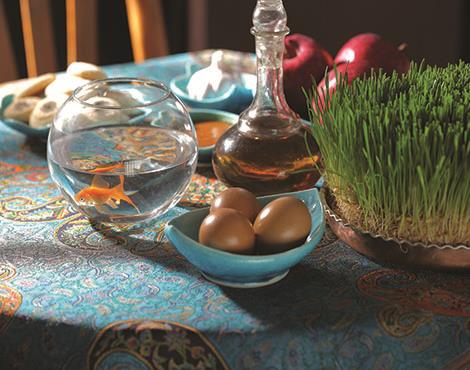Nowruz, Persian New Year

Nowruz marks the first day of Farvardin
and the beginning of the year in the Persian solar calendar. Nowruz is the
symbol of birth of plants, nature’s regeneration, and celebration of the earth
and life.
It is the only celebration that a
smaller celebration comes before it (Charshanbeh Suri) and another celebration
after it (Sizdeh Bedar). In fact Nowruz has an introduction and conclusion
which are themselves much bigger than celebrations as Yalda Night.
The oldest document at hand about
Nowruz is the “Shahnameh”.
Nowruz which is established for
about two to three thousand years with all the customs and rituals is a symbol
of Iranian’s stability in keeping their national rituals.
“Nowruz is one of the symbols of
our nation. Nowruz is the day of manifestation of Iranian spirit. Nowruz is the
proof for this claim that Iran is still young and strong despite its antiquity.”
Nowruz Customs and Rituals
Preparations for Nowruz begin in
the month Esfand, the last month of winter in the Persian solar calendar.
·
Spring cleaning – cleaning the environment
·
Preparing grass of wheat,
lentils, vetch seeds, or cress
·
Sending gift cards
·
“CharshanbehSoori” (is the
Iranian’s fire jumping festival which takes place on the eve of the last
Wednesday before Nowruz. “Suri” means red flame, which means light prevail
darkness and by lighting fire, the remaining of the cold is vanished. “Char” (four)
is the symbol of four seasons. “CharshanbehSoori” belongs to the Islamic
Period.)
·
Self-cleaning – bathing, wearing new clothing
·
The prayer for the start of
New Year and asking forgiveness
·
Visiting relatives and
eliminating the hatred
“SizdehBedar” (the Thirteenth Day
of Farvardin, a festival in Persian Culture on which Iranian people leave the
house and joyfully spend the day outdoors.)
“Haft Sin” Supplies
“Sofreh Haft Sin” has been one of
the integral parts of Nowruz.
It is composed of:
MIRROR is a symbol of light and
sincerity.
QURAN causes blessing and the
other parts of the “Sofreh Haft Sin” is set relying on it.
CANDLES is put to the number of
the children of the family and is the symbol of lightness.
A BOWL OF WATER WITH AURANTIUMS
FLOATING ON IT is a symbol of the earth and its rotation on water.
COOKIES is the sweetness of life.
GRASS (Sabzeh): represents growth
and blessing in the New Year and a symbol of greenness and freshness, bliss,
generation, and germination of plants in the spring.
GARLIC (SIR) indicates
disinfection and cleanliness.
SUMAC (SOMAGH) is the symbol of
life and stimulates happiness and wellness.
COINS (SEKKEH) is a symbol of
bliss.
SEA-BUCKTHORN (SENJED) is a
symbol of love and romance, represents life.
VINEGAR (SERKEH) is the symbol of
patience.
SAMANO OR THE HOLY HALVA is
considered the symbol of growth and fertility.
RED APPLE (SIB) is a heavenly
fruit and a symbol of beauty and health.
COLORED EGGS symbolizes
sustenance, fertility and blessing.
GOLDFISH is the symbol of Pisces
or “Esfand” and
represents life and refreshness.
HYACINTH (SONBOL) represents
beautiful flowers.
NUTS symbolizes bliss and
abundance.
ESFAND is burnt along with amber
and fragrant woods for disaster and sour eye relief.
WHEAT AND RICE are symbols of
bliss and benediction.
Normal
0
false
false
false
EN-US
X-NONE
AR-SA
